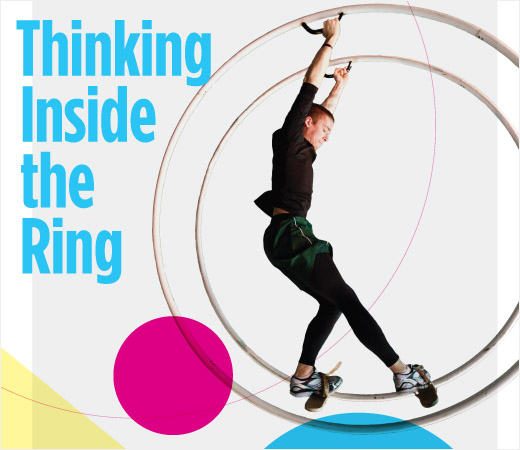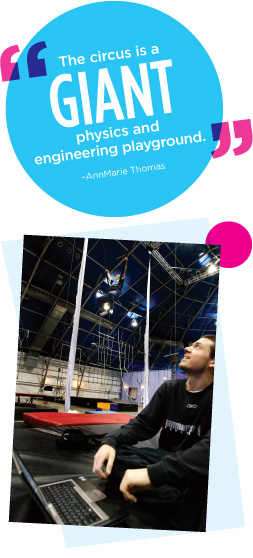The 24/7 Tutor

Above: Student Jim Portmann tests the German Wheel.
An original dynamics course brings engineering under the big top.
Teetering on a narrow metal bar 30 feet from the floor, AnnMarie Thomas lets go of the support ropes and hurtles downward. When she’s a heartbeat away from certain injury, the bungee cords attached to her waist spring into action. She bounces back in a succession of rebounds and plunges, each oscillation shorter than the last, until her motion stops.
Barnum & Bailey? No, it’s dynamics as taught by Thomas, an assistant professor of engineering at the University of St. Thomas in St. Paul, Minn., who believes in going above and beyond the standard curriculum. A juggler and circus enthusiast since her youth, Thomas contends that acrobatics offer an ideal way to convey concepts like movement, momentum, and Lagrangian dynamics: “The circus is a giant physics and engineering playground.” And who says engineering theory has to be boring? After Thomas climbs down from the trapeze, each student gets a turn—no pre-training required. “When you’re having fun, you’re going to remember things,” she tells them.
Thomas, trained as a mechanical engineer, was inspired to produce the course while taking a flying trapeze class at Circus Juventas, one of at least two circus schools in the St. Paul area. CJ agreed to serve as the class laboratory, with coaches on hand to help students use the equipment safely. Thomas taught the course alongside Keith Berrier, an electrical and aerospace engineer whom she met in the trapeze class. He has since become an adjunct instructor in electrical engineering and design at St. Thomas.
The course was given just once, in the winter of 2009, a period St. Thomas sets aside for intensive one-month classes, but the instructors would like to offer it again and say it could be replicated in any city with a circus training facility. It features five circus acts, each chosen to illustrate how a particular simple machine functions. Besides joining in the acrobatics, students worked out equations to anticipate movements for each act. They recorded the stunts with video cameras and then used software to calculate the actual movements, compare them with the anticipated results, and analyze any discrepancies.
The first act, known as the German wheel, works like a disc rolling on a plane. Essentially a cylinder made from two 8-feet-in-diameter hoops with a common axis, the wheel rolls side to side when a performer—or college student—shifts his or her center of mass. The person inside executes a series of perfect, guided cartwheels. Calculations of the act’s velocity and acceleration points are simple, allowing for the best predictions and “beautiful data,” according to Thomas.
The heart-pounding bungee trapeze, employing a high platform and a set of bungee cords, functions like a classic mass and spring. Student groups measured damped oscillations and derived a theoretical equation to account for and compare to the real-world data. Two other acts, the famous flying trapeze and its smaller cousin, the low-casting trapeze, are more like large pendulums. Students calculated equations of motion, using both humans and weights, and attempted to discover whether trapezes most resembled simple or double pendulums.
In the fifth and final activity, known as the Spanish web, the students climb a rope and begin spinning with help from a coach or instructor. Over time, the speed increases and the body whirls around at a dizzying pace. The faster the person rotates, the higher the body lifts. Given the ability to go fast enough, the figure would become purely horizontal. The students had to figure out, given the speed, what angle would be obtained in relation to the weight of the person. A simpler version would be to hold a bucket of water and spin around. With increased speed, the arm holding the bucket ascends.
Among the motion-analysis software tools used were PASCO2 Amusement Park Physics Bundle sets, which consist of a data-logger; a three-axis acceleration altimeter sensor and vest to hold them; a human movement analysis program called KA Video3; and Dartfish4 image processing software. The programs, on loan from the university’s health and human performance department, were new for the students, but graduate student Andrea Guggenbuehl was on hand to show them the ropes.
Though active participation wasn’t required, every student jumped at the chance to tackle all the activities with Thomas and Berrier. Safety lines meant they could perform without prior training or any real risk of injury. William Besser, a mechanical engineering and business management double-major who took the class as a sophomore, even conquered his fear of heights to take on the flying trapeze. The course’s sole female student decided because of the class to add a second major in mechanical engineering.
Thomas says this kind of active learning can be more effective than lectures and textbooks, and mounting pedagogical evidence backs her up. A 2011 study involving a large-enrollment physics class by University of British Columbia researchers found that with active learning, attendance grew, engagement rose, and students learned twice as much as a control group in a traditional lecture setting. Moreover, a 2009 study from Loughborough University showed that along with virtual simulations, software use, and post-activity reflection, which Thomas’s course utilized, hands-on learning was essential to grasping information.
When there were data discrepancies between anticipated numbers and actual numbers for the bungee trapeze, the class discussed exactly how and why that occurred. “How we measured the K value” was “a little bit crude,” Thomas says. The sensors from PASCO2, designed for more general data taken by students at the K-12 level, were not as accurate as would be ideal, and since the students didn’t go up into the rafters of the big top to measure exact lengths, errors could have come from there, too. But,Thomas says, uncertainty in data is much more like the real world and thus important for students to see.
The course culminated in a performance for sixth graders featuring student-executed acts designed to convey basic science concepts. In lieu of a final exam, they worked together in small groups to prepare mini-lessons for kids from Farnsworth Aerospace School, which is tied to a precollegiate education center Thomas runs. Besser’s team used the German wheel to demonstrate gravity and simple science, while another group used the low-casting trapeze to explain potential and kinetic energy conversion. The latter included a discussion on how breakfast gives circus performers the energy to accomplish their feats.
A student in the German wheel group slipped and fell during the demonstration. Before returning to complete the maneuver successfully, the student transformed the slip-up into an impromptu lesson for the grade school pupils, telling them that engineering was about making mistakes and learning from them. To Thomas, this unscripted moment was a highlight of the course. Their presentation was such a smash that they were invited to perform again for the general public at Circus Juventas’s anniversary celebration, “World Circus Day.”
For Besser and his classmates, the course provided another unanticipated benefit: Performing the Spanish web and other feats persuaded them they were out of shape. Now, they hit the gym more often.
Jaimie N. Schock is ASEE’s editorial assistant.
Category: Teaching
